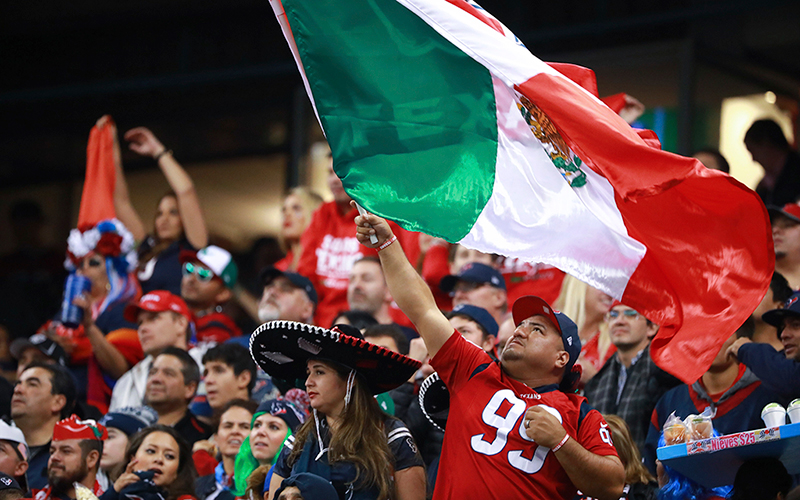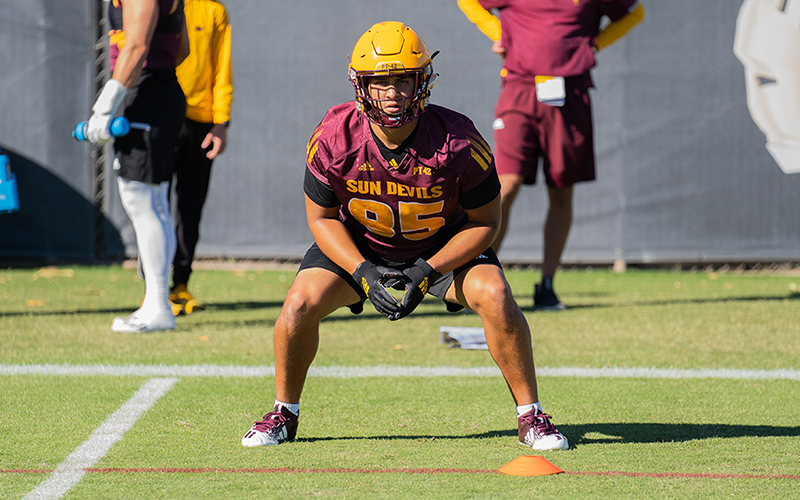
Although NFL games played in Mexico attract a large fan base, and the sport is popular in many Latin American countries, the excitement doesn’t translate to participation on the field. (Photo by Hector Vivas/LatinContent via Getty Images)
PHOENIX – During JR Alcantar’s time as head football coach at Cesar Chavez High School, he frequently watched players miss practice. The need to work outside the home to help support families was common at a place where more than 65 percent of enrolled students are Hispanic.
Getting them noticed by colleges? An even bigger challenge.
“It’s hard for them to get recruited because they don’t have the access to get recruited through hiring an extra recruiter or even understanding at home,” said Alcantar, now an assistant at Canyon View High in Waddell. “At Cesar Chavez, we gave our kids cell phones and gave them a hotspot so that the majority of them could have access at home to use a computer.”
It is one reason the popularity of the sport among Hispanic Americans doesn’t translate to participation on the field at all levels.
Disparity in numbers
While it may not be as vibrant as soccer’s following, football has a large, thriving Hispanic fanbase.
Over 30 million Hispanic Americans consider themselves NFL fans, according to a SSRS/Luker on Trends Sports Poll. The NFL believes more than 22 million citizens in Mexico identify as NFL fans, and that there are more than 40 million league fans who reside in Latin America overall.
In fact, the NFL’s single-game attendance record was set at the Estadio Azteca in Mexico City in 1994 when 112,376 spectators watched a preseason matchup – yes, preseason – between the Houston Oilers and Dallas Cowboys.
Despite this, those numbers fail to translate to participation in the sport at all levels.
Latinos made up 18.7% of the U.S. population in 2020, according to the U.S. Census Bureau. Yet, only 0.5% of NFL players identified as Latino at the start of the 2019 season, according to the Institute for Diversity and Ethics in Sport.
The lack of Hispanic representation in the NFL can also be seen at the collegiate level. Only about 3% of Division I football players in 2020 identified as Hispanic or Latino, according to the NCAA Race and Gender Demographics Database,
It is difficult to pinpoint why there aren’t there more Hispanics in football, but it’s clear it starts at the youth and high school level.
“I feel like it comes from the parents,” Arizona State offensive lineman Marco Salas said. “They kind of stray their kids away from that because of the physicality of the sport, and they would rather have them play a different sport like soccer or baseball.”
Economics play a role, too.
The Hispanic population is the largest minority group in the U.S. and has the third highest poverty rate behind Native Americans and African Americans, according to the U.S. Census Bureau.
With the cost of playing football, some Hispanic communities may struggle to maintain a team at the youth and high school levels.
“In some of these neighborhoods, these guys can’t even buy balls,” Saguaro High School defensive coordinator Jim Camarillo said. “They can’t buy footballs, these kids don’t have cleats, moms have to do car washes so they can buy some T-shirts so they all look like a team when they go out there.
“It’s just a matter of where you grow up and the support you have. There are some communities that don’t have an organized team. It really makes it hard for parents to get their kids involved when it’s just not there.”
Canyon View’s Alcantar agrees. Teams have a much easier time when their booster clubs are from a healthy socioeconomic area because it allows them to buy sufficient equipment, he said.
The economic situation of some Hispanic communities also impacts players individually.
Some players may not be able to afford and eat the right food, Still, they are required to lift, lose weight and gain muscle with the wrong nutrients in their body.
Furthermore, some schools can’t afford tutoring for students. As a result, these players may not be able to get into a college or university because they are struggling academically and do not meet the eligibility requirements.
“How are we going to help them if we have no money to help them?” Alcantar said.
It is not the same at Canyon View.
“Where I’m at now, there’s no issues with that,” he said. “The demographics and socioeconomics is way better, so those kids don’t have to have that struggle.”

As part of the small percentage of Hispanic Division I football players, ASU tight end Ryan Morgan hopes to encourage participation at the youth level by sharing his own experience. (Photo by Julian Rosa/Cronkite News)
Family comes first
Family is emphasized in the Hispanic culture. Combine that with challenging economic circumstances, and it creates a phenomenon where prospects are opting to forgo college football to enter the workforce right away.
“That’s an issue you deal with coaching kids like that,” Alcantar said. “The majority of my kids that needed to work were Hispanic kids. They needed to help their family. Mom and dad either were illegal or they didn’t have the jobs that some people with an education had. They had to work a little harder to get that extra money, and they had to have their own sons and daughters work and try to pull in that extra cash to help out the family. It’s unfortunate.”
Camarillo believes that while other cultures may look at football as a way out, the Hispanic culture deters players from moving far away when they could help the family now. This is especially true for families of athletes who aren’t heavily recruited and may have to attend a lower-level school to continue playing football.
“Why would you want to leave the family business to basically go continue high school?” Camarillo said. “Not every family looks at it as getting a degree.”
This trend is also evident with players at larger programs who are not on full athletic scholarships.
“It can be very difficult, especially if you’re a walk-on wanting to go into college football,” ASU tight end Ryan Morgan said. “Your Hispanic family will be like, ‘Now, we have to pay for your college, and you’re not getting enough time to make money for the family and for yourself to grow.’”
Today we recognize the Hispanic and Latino communities that have helped shape the identity of The Valley we call home. ??#HispanicHeritageMonth pic.twitter.com/2uqcE4Dyfm
— Sun Devil Football (@ASUFootball) October 9, 2021
The players might have a potential future in football but are left with few options. While there could be additional pressure from family, this mindset is ingrained in the culture, and athletes may feel compelled to drop the sport because of it.
“I feel like it’s more in our culture,” ASU offensive lineman Ralph Frias said. “It’s something you want to do right away. Not necessarily pressure from family, but it’s pretty much what you’ve been through and you see the struggles. I have friends that had that potential to go and carry on to the next level but really needed to support their families right away, so they go out and get jobs.”
The underrepresentation of Latinos in football is also evident in the lack of head coaches.
Only seven of the 130 head coaches in Division I football are Latino.
These numbers for players and coaches are comparable at the high school level, despite the high Hispanic population percentages in many states. In 2019, Arizona had the fourth highest Hispanic population percentage in the country at 31.33% behind New Mexico (48.79%), Texas (39.34%) and California (39.02%).
“It’s disappointing we don’t have more,” Alcantar said.
One possible obstacle preventing more Hispanic high school coaches is the requirement of teacher certifications.
Some states and school districts require coaches to also work as full-time teachers at their respective schools, Camarillo said. To obtain a teacher certification, applicants must hold a bachelor’s degree and usually have to complete a preparation program.
It would be costly to go to college to obtain a certificate for a job that may not be able to pay the bills. For that reason, it limits the opportunities for some Hispanics looking for a coaching job.
“At the high school level, it does affect some guys’ ability to get a certain job because he’s not qualified,” Camarillo said. “Probably qualified from a football perspective, but not from a teacher certificate perspective.”

ASU offensive lineman Marco Salas hopes to leave behind his own legacy. As a Mexican American, Salas experienced firsthand the stark difference between having a Hispanic coach who he can relate to and having a coach of a different background. (Photo by Julian Rosa/Cronkite News)
Seeking a solution
Relative to the Hispanic population in the U.S., representation in football is severely lacking.
Can things change?
On the coaching side, Camarillo founded the Minority Football Coaches Network in January 2019. He wanted to create a network of coaches in Arizona who can effectively communicate with each other while also providing opportunities to raise money to pump back into the communities that need it most.
Having Hispanic coaches also impacts the Hispanic athletes who play under them.
Salas, a Mexican American, experienced the dichotomy of having a Hispanic coach and a white one. After having a Hispanic offensive line coach for his first three years at Dobson High School, Salas said he had to adjust during his senior year after discovering that his new offensive line coach was white.
“We didn’t have that same connection that I did with my previous coach because he kind of knew what some of us were coming through, and we had that same background with him compared to the white O-line coach I had,” Salas said.
Through organizations like the Minority Football Coaches Network, there could be a rise in the number of opportunities for Hispanic coaches to help players with similar backgrounds feel more comfortable in the sport.
It is difficult for a coach to reach a player if they do not understand the player’s culture or background, Alcantar said. Having a coach who can relate to the culture in which Hispanic players were raised is crucial because it builds a sense of trust between the coach, player and even parents.
“I grew up the same way they did,” Alcantar said. “I grew up in a Hispanic culture where family was always first, and you always helped each other. That was how we were raised. With those kids, I can relate. I can understand how they grew up.
“I think those kids needed somebody like me. I’m more of a driven worker when it comes to my babies. Those are my kids. I’m going to bust my butt for them and make sure they’re given the opportunities I never had.”
Educating young athletes about success stories involving Hispanics in football could encourage more to continue in the sport.
NFL Hall of Famers Anthony Muñoz and Tom Flores are two of the most well known Hispanic members in the sport and are often considered prime models to emulate.
More recently, Arizona athletes can look toward Roy Lopez III for inspiration. The former Gilbert Mesquite High School and University of Arizona defensive lineman was drafted by the Houston Texans in the sixth round of the 2021 NFL Draft, becoming one of only 24 active Latino players in the NFL. His father, Roy Lopez Jr., is currently the head football coach at Desert Ridge High School.
#LatinxHeritageMonth spotlight: DL @RLopez_51 – 1 of only 24 Latinx players in the @NFL.
Join Somos Texans for a chance to win his jersey!
— Houston Texans (@HoustonTexans) September 20, 2021
“That’s important to show the boys,” Alcantar said. “It doesn’t matter where you start from, it’s how you end and how you finish. You can do it. You may have to go through trials and tribulations, but you can get there.”
The success stories do not end at the NFL level.
Salas, Frias and Morgan have the distinction of being part of the 3% of Hispanic Division I football players, and they hope to play a role in increasing Hispanic participation in the sport by sharing their experiences with younger athletes.
“The best thing we can probably do is be involved with lower-level teams that have Hispanic kids on them,” Morgan said. “Building a good base with Hispanic players will eventually lead to more Hispanic coaches. Just being able to talk to those kids and share our experiences and tell them how it can be a really good opportunity can help bring more Hispanic kids into the NCAA and eventually coaching.”
Hispanic players may continue to grow up hearing the claim that they are better suited to play a different sport. However, with more encouragement and continued hard work, there could be a gradual increase in participation across the board to more closely represent the Hispanic population within the U.S.
“We can prove those naysayers or the doubters wrong and show that Mexicans and Hispanics can actually play other sports,” Salas said. “We can play football and excel at it at a high level. There’s people out here that have done it before, so follow in their footsteps and leave your own legacy.”


